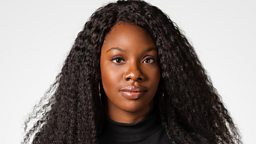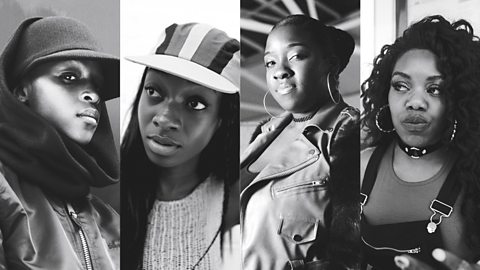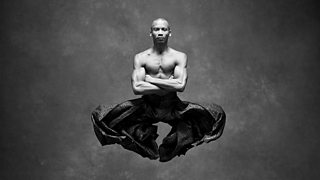Where are all the black women in Grime?
Journalist and Grime fan Yomi Adegoke noticed something lacking when it comes to discovering and enjoying the genre of music she loves. Women who look like her.
Here, Yomi describes her journey through the music industry for Radio 4's Where are all the black women in Grime?, examines the representation of black women in the UK Grime scene and finds out whether things might be changing.

As a long time Grime fan, I’ve always been interested in documenting the gaps in its history, previously searching for the ‘lost stars’ of now-defunct, This year, I decided to highlight another group missing in action - black women.
There is a dearth of successful black female artists, but what is less well known is that behind the scenes, many of the biggest female names who have worked or are still working within the industry are white.
Whether as MC’s, managers, journalists or taste-makers, black women are underrepresented in Grime.
There is a dearth of successful black female artists, but what is less well known is that behind the scenes, many of the biggest female names who have worked or are still working within the industry are white - Hattie Collins, Olivia Rose, Hyper Frank, Chantelle Fiddy to name a few.
There are a number of white men who have risen within the ranks over the years too - Logan Sama, Charlie Sloth, Tim Westwood - but they are still greatly outnumbered by black men, which cannot be said when it comes to black and white women.

Women in the Grime scene
Who are the women in the industry we should be taking notice of?
As a genre with its roots in the black working class, this begs the question of whether black women are simply sidelined whilst in the industry or hardly present at all.
It’s a hard question to answer. The Grime scene is notoriously insular and many were quick to close ranks when the conversation became specifically about black women.
Discussion along the lines of gender are abundant: there are articles and initiatives on the lack of women in Grime every other week. But when the focus becomes about black women in particular, the conversation becomes a great deal quieter.
When I first set out to document the issue, a white female insider replied to my request for an interview with: “I only want to take part in an article celebrating all women pushing Grime forward – such as myself.”
-
![]()
Where are all the black women in Grime?
Yomi Adegoke examines the representation of black women in the UK Grime scene.
As a black woman, who writes primarily about both of these facets of my identity, getting contributors to open up about the invisibility of women who were like me was initially difficult.
In asking where the black women are in Grime, we also have to ask where the black women are in any other music genre.
Very few black men and white women are willing to speak up on behalf of black women, perhaps as Dr Joy White, an academic of the Independent Social Research Foundation suggests, for fear of revealing complicity. The majority of insiders willing to put their heads above the parapet, albeit hesitantly, were black women.
Though many were understandably worried about potential repercussions, they spoke openly about the difficulties faced in the industry of which there were several. In the documentary, DJ Kaylee Kay from the platform spoke about how black women were often written off as ‘bitter’, the angry black woman stereotype colouring their valid grievances before they were even aired.
In terms of preferential treatment, perceived proximity to whiteness played as much of a part as whiteness, too: in an un-aired clip, veteran MC Stush spoke about her continually pitted against fairer skinned artist Ms Dynamite because of her darker complexion. Grime artist Lioness is another who spoke about her skin tone was deemed a hindrance to her career.
Colourism - the favourable treatment of lighter skinned black people compared to those who are darker skinned - is a seed that was planted by white supremacy, but watered within our own communities.
The effect the colour of your skin has is not so black and white: whilst race impacts who is seen and heard, so does skin shade, but it’s a penalty only women seem to pay in the scene. Dark-skinned men in Grime are highly visible, both behind the scenes and in front of the camera.
Why aren't there more black or Asian ballet dancers?

Traditionally, there haven't been many black or Asian dancers in mainstream ballet companies but that's starting to change.
It’s important to acknowledge that this isn’t a ‘Grime problem’ - it is a music industry problem.

In R&B and pop music drawing from soul, artists like Jess Glyne, Anne Marie and Adele remain the faces. In a genre like Afrobeats, gender as opposed to race is the issue – artists like Wizkid, Davido and Burna Boy’s presence is being felt increasingly on the worldwide stage and women continue to lag behind.
In asking where the black women are in Grime, we also have to ask where the black women are in any other music genre, particularly in Britain. They tend to be in the same place in each scene - overlooked.
More from Radio 4
-
![]()
Where are all the black women in Grime?
Yomi Adegoke examines the representation of black women in the UK Grime scene.
-
![]()
An exploration of black-related words
Exploring black British identity through language.
-
![]()
Hiplet: can hip hop save ballet?
Can the hip-hop/ballet fusion of Hiplet can encourage greater participation?
-
![]()
17 Multicultural London English words and what they mean
Blud, peng, mandem and more.




